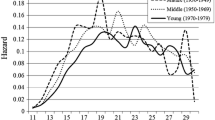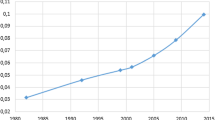Abstract
This study investigates gender-specific changes in the total financial return to education among persons of prime working ages (35–44 years) using U.S. Census data from 1990 and 2000, and the 2009–2011 American Community Survey. We define the total financial return to education as the family standard of living as measured by family income adjusted for family size. Our results indicate that women experienced significant progress in educational attainment and labor market outcomes over this time period. Ironically, married women’s progress in education and personal earnings has led to greater improvement in the family standard of living for married men than for women themselves. Gender-specific changes in assortative mating are mostly responsible for this paradoxical trend. Because the number of highly educated women exceeds the number of highly educated men in the marriage market, the likelihood of educational marrying up has substantially increased for men over time while women’s likelihood has decreased. Sensitivity analyses show that the greater improvement in the family standard of living for men than for women is not limited to prime working-age persons but is also evident in the general population. Consequently, women’s return to education through marriage declined while men’s financial gain through marriage increased considerably.



Similar content being viewed by others
Notes
However, Hubbard (2011) argued that no gender difference exists in the college wage premium after correcting for bias associated with top-coding.
Because we use the three-year combined ACS, we considered the sensitivity of our results by changing the sample restriction to those who were born in 1966–1975, finding that the results are almost identical. Using the ACS 2010 one-year sample instead of a three-year combined sample does not alter our conclusion, either.
Even within nuclear families, resource allocation can be skewed depending on power relations between couples and related transaction cost considerations (Agarwal 1997; Bergstrom 1996). How well this assumption holds is very difficult to test because the decision to participate in the labor force is not exogenous with respect to the allocation of resources within the family (Lundberg et al. 1997).
The proportion living with partners, friends, or visitors is only 4.2 % among persons aged 35–44 in 2009–2011.
Why single women’s incomes grew more slowly than equally educated single men is another question beyond the scope of this study and should be investigated in future research.
The analyses of the change between 1990 and 2000 and the change between 2000 and 2009–2011 yield the same conclusion that we present here.
Mathematically, the log of a sum does not equal the sum of the logs.
References
Agarwal, B. (1997). “Bargaining” and gender relations: Within and beyond household. Feminist Economics, 3(1), 1–51.
Aughinbaugh, A., Robles, O., & Sun, H. (2013). Marriage and divorce: Patterns by gender, race, and educational attainment. Monthly Labor Review, October, 1–16.
Bailey, M. J. (2006). More power to the pill: The impact of contraceptive freedom on women’s life cycle labor supply. Quarterly Journal of Economics, 121, 289–320.
Becker, G. S. (1991). A treatise on the family. Cambridge, MA: Harvard University Press.
Bergstrom, T. C. (1996). Economics in a family way. Journal of Economic Literature, 34, 1903–1934.
Blau, F. D., & Kahn, L. M. (2006). The U.S. gender pay gap in the 1990s: Slowing convergence. Industrial and Labor Relations Review, 60, 45–66.
Brand, J. E., & Davis, D. (2011). The impact of college education on fertility: Evidence for heterogeneous effects. Demography, 48, 863–887.
Breen, R., & Salazar, L. (2011). Educational assortative mating and earnings inequality in the United States. American Journal of Sociology, 117, 808–843.
Buchmann, C., & DiPrete, T. A. (2006). The growing female advantage in college completion: The role of family background and academic achievement. American Sociological Review, 71, 515–541.
Buss, D. M., Shackelford, T. K., Kirkpatrick, L. A., & Larsen, R. J. (2001). A half century of mate preferences: The cultural evolution of values. Journal of Marriage and Family, 63, 491–503.
Card, D., & DiNardo, J. E. (2002). Skill–biased technological change and rising wage inequality: Some problems and puzzles. Journal of Labor Economics, 20, 733–783.
Charles, K. K., & Luoh, M. C. (2003). Gender differences in completed schooling. Review of Economics and Statistics, 85, 559–577.
Cherlin, A. J. (2004). The deinstitutionalization of American marriage. Journal of Marriage and Family, 66, 848–861.
Cherlin, A. J. (2005). American marriage in the early twenty-first century. Future of Children, 15(2), 33–55.
DiPrete, T. A., & Buchmann, C. (2006). Gender-specific trends in the value of education and the emerging gender gap in college completion. Demography, 43, 1–24.
DiPrete, T. A., & Buchmann, C. (2013). The rise of women: The growing gender gap in eduation and what it means for American schools. New York, NY: Russell Sage Foundation.
Dougherty, C. (2005). Why are the returns to schooling higher for women than for men? Journal of Human Resources, XL, 969–988.
England, P. (2010). The gender revolution: Uneven and stalled. Gender and Society, 24, 149–166.
England, P., & Farkas, G. (1986). Households, employment, and gender: A social, economic, and demographic view. New York, NY: Aldine Pub. Co.
Fernandez, R., Guner, N., & Knowles, J. (2005). Love and money: A theoretical and empirical analysis of household sorting and inequality. Quarterly Journal of Economics, 120, 273–344.
Goldin, C. (1997). Career and family: College women look to the past. In F. D. Blau & R. G. Ehrenberg (Eds.), Gender and family issues in the workplace (pp. 20–58). New York, NY: Russell Sage Foundation Press.
Goldin, C. (2006). The quiet revolution that transformed women’s employment, education, and family. American Economic Review, 96, 1–21.
Goldin, C., Katz, L. F., & Kuziemko, I. (2006). The homecoming of American college women: The reversal of the college gender gap. Journal of Economic Perspectives, 20(4), 133–156.
Grogger, J., & Eide, E. (1995). Changes in college skills and the rise in the college wage premium. Journal of Human Resources, 30, 280–310.
Hubbard, W. H. (2011). The phantom gender difference in the college wage premium. Journal of Human Resources, 46, 568–586.
Kim, C., & Sakamoto, A. (2008). The rise of intra-occupational wage inequality in the United States, 1983 to 2002. American Sociological Review, 73, 129–157.
Lehrer, E., & Nerlove, M. (1986). Female labor force behavior and fertility in the United States. Annual Review of Sociology, 12, 181–204.
Leicht, K. T. (2008). Broken down by race and gender? Sociological explanations of new sources of earnings inequality. Annual Review of Sociology, 34, 237–255.
Long, M. C. (2010). Changes in the returns to education and college quality. Economics of Education Review, 29, 338–347.
Lundberg, S. J., Pollak, R. A., & Wales, T. J. (1997). Do husbands and wives pool their resources? Evidence from the United Kingdom Child Benefit. Journal of Human Resources, 32, 463–480.
Mandel, H., & Semyonov, M. (2014). Gender pay gap and employment sector: Sources of earnings disparities in the United States, 1970–2010. Demography, 51, 1597–1618.
Mare, R. D. (1991). Five decades of educational assortative mating. American Sociological Review, 56, 15–32.
McCall, L. (2000). Explaining levels of within-group wage inequality in U.S. labor markets. Demography, 37, 415–430.
McKinnish, T. (2008). Spousal mobility and earnings. Demography, 45, 829–849.
Morris, M., & Western, B. (1999). Inequality in earnings at the close of the twentieth century. Annual Review of Sociology, 25, 623–657.
Murphy, K. M., & Welch, F. (1992). The structure of wages. Quarterly Journal of Economics, 107, 285–326.
Musick, K., England, P., Edgington, S., & Kangas, N. (2009). Education differences in intended and unintended fertility. Social Forces, 88, 543–572.
Oppenheimer, V. K. (1994). Women’s rising employment and the future of the family in industrial societies. Population and Development Review, 20, 293–342.
Oppenheimer, V. K. (1997). Women’s employment and the gain to marriage: The specialization and trading model. Annual Review of Sociology, 23, 431–453.
Parker, K., Horowitz, J. M., & Rohal, M. (2015). Parenting in America: Outlook, worries, aspirations are strongly linked to financial situation (Pew Research Center report). Retrieved from http://www.pewsocialtrends.org/2015/12/17/parenting-in-america/
Ruggles, S., Genadek, K., Goeken, R., Grover, J., & Sobek, M. (2015). Integrated Public Use Microdata Series: Version 6.0 [Data set]. Minneapolis: University of Minnesota.
Schwartz, C. R. (2013). Trends and variation in assortative mating: Causes and consequences. Annual Review of Sociology, 39, 451–470.
Schwartz, C. R., & Han, H. (2014). The reversal of the gender gap in education and trends in marital dissolution. American Sociological Review, 79, 605–629.
Schwartz, C. R., & Mare, R. D. (2005). Trends in educational assortative marriage from 1940 to 2003. Demography, 42, 621–646.
Snyder, T. D., Dillow, S. A., & Hoffman, C. M. (2008). Digest of education statistics, 2007 (NCES Report No. 2008-022). Washington, DC: National Center for Education Statistics, Institute of Education Sciences, U.S. Department of Education.
Stiglitz, J., Sen, A., & Fitoussi, J.-P. (2009). The measurement of economic performance and social progress revisited: Reflections and overview (OFCE Report No. 2009-33). Paris, France: Centre de Recherche en Économie de Sciences Po.
Sullivan, O. (2006). Changing gender relations, changing families: Tracing the pace of change over time. Lanham, MD: Rowman & Littlefield Publishers.
Sweeney, M. M. (2002). Two decades of family change: The shifting economic foundations of marriage. American Sociological Review, 67, 132–147.
Sweeney, M. M., & Cancian, M. (2004). The changing importance of white women’s economic prospects for assortative mating. Journal of Marriage and Family, 66, 1015–1028.
Tomaskovic-Devey, D., Zimmer, C., Stainback, K., Robinson, C., Taylor, T., & McTague, T. (2006). Documenting desegregation: Segregation in American workplaces by race, ethnicity, and sex 1966–2000. American Sociological Review, 71, 565–588.
Wang, W. (2014). Record share of wives are more educated than their husbands. Pew Research Center Fact Tank. Retrieved from http://www.pewresearch.org/fact-tank/2014/02/12/record-share-of-wives-are-more-educated-than-their-husbands/
Acknowledgments
We thank the Editor and the anonymous reviewers of Demography for helpful comments. Thanks also to Kimberly Goyette, Young-mi Kim, and Yool Choi for their comments. Earlier versions of this article were presented at the 2015 RC28 summer meeting and at Yonsei University in Seoul, Korea. ChangHwan Kim received financial support for this study from the University of Kansas (GRF #2301065).
Author information
Authors and Affiliations
Corresponding author
Rights and permissions
About this article
Cite this article
Kim, C., Sakamoto, A. Women’s Progress for Men’s Gain? Gender-Specific Changes in the Return to Education as Measured by Family Standard of Living, 1990 to 2009–2011 . Demography 54, 1743–1772 (2017). https://doi.org/10.1007/s13524-017-0601-3
Published:
Issue Date:
DOI: https://doi.org/10.1007/s13524-017-0601-3




